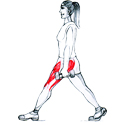-

|
-

|
| Step 1 |
Step 2 |
- Targeted Muscles:
- Hamstring
- Quadriceps
- Buttocks (gluteus maximus)
- Additional Muscles:
- Hip Flexors
- Calves (gastrocnemius and soleus)
- Inner Thighs (adductors)
- If you have trouble keeping balance, you can perform a stationary lunge, which you may find more stable. Start with your right foot flat on the floor about one stride length in front of your left foot. Your feet should be shoulder width apart. Bend your knees and lower your body for two seconds, pause for one second and then raise your body for two seconds. Make sure you do not move your feet. After you complete a set, switch legs and repeat the exercise.
- After you have mastered the basic lunging technique, you can perform variations, such as reverse lunges and walking lunges. You perform reverse lunges the same way you perform regular lunges except that you step backward instead of forward. To perform a walking lunge, instead of returning your front leg to the starting position after your first lunge, lean your weight forward on your front leg, lift your back leg in and lunge forward with your back leg. Then continue alternating legs as you travel forward.
- Lunges form and tone your quadriceps, hamstrings and buttocks, as well as your hip flexors, inner thighs and calves.
- This exercise strengthens your legs and helps improve your balance, which is particularly beneficial for activities that require vigorous legwork, such as tennis or squash. Since lunges involve deep knee bending, you should avoid this exercise if you have knee problems.
- Depending on your fitness level, you may want to use weights while performing lunges. When using dumbbells, hold a dumbbell in each hand with your arms at your sides and your palms facing your legs. To use a barbell, hold the bar across your upper back with your palms facing forward. When using a barbell, remember to keep the wrist and elbow of each arm in a straight line. Keep in mind that adding weights increases the intensity of the exercise and may take maintaining your balance more difficult.
- When performing lunges, try to keep your back straight and look straight ahead to help maintain your balance.
- Do not allow your front knee to pass your toes.
- Do not twist your body or lean forward. Your shoulders should be square and face forward.
- Do not point your toes in or out. Your toes should point straight ahead.
- Do not land on the toes of your front foot when stepping forward. Make sure your front foot is flat on the floor.
|











